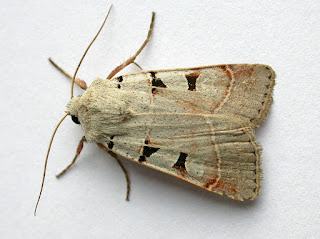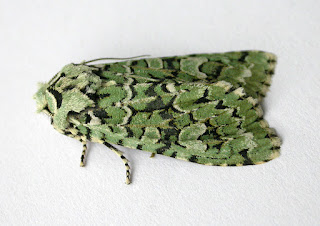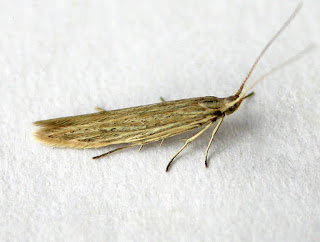I agree with Dave about the smartness of the Autumnal Rustic, which is currently visiting here, but grey moths in general don't float my boat. May I ask for help with these; I think the Wave is a Small Dusty but am not completely sure and the others have me scratching my head in despair. Many thanks for enlightenment. Martin Wainwright, Thrupp, Oxon
Tuesday, 27 September 2022
Monday, 26 September 2022
Grey and Green
 |
| Autumnal Rustic, Grangelands 21st September |
 |
| Brindled Green, Finemere Wood 22nd September |
 |
| Figure of Eight, Oakley Wood 23rd September |
 |
| Merveille du Jour, Shabbington Wood 25th September |
Saturday, 24 September 2022
Autumn moths
The season continues to move on: Square-spot Rustic has almost entirely given way to Lunar Underwing in my garden, with a generous dollop of Large Yellow Underwing. A few more interesting moths have also arrived, the first of which seems to be a Scarce Bordered Straw.
Moving from rather drab species to smarter-looking ones: on Wednesday night, I had a colourful mix of Barred Sallow, Pink-barred Sallow and Orange Sallow. Autumnal Rustic has started to put in its annual handful of records: three so far, on two nights.
 |
| Scarce Bordered Straw Newton Longville, 21 September 2022 |
 |
| Autumnal Rustic NL, 21 September 2022 |
I also had what I think is Ditula angustiorana on the 19th, although it was not in good shape. It's very late for its main season, but the field guide mentions a partial second brood in September-October, so perhaps that's what it was.
 |
| Ditula angustiorana? Newton Longville, 19 September 2022 |
I also try to identify and record as many as possible of the other insects that come to light and now that I have fewer species of moth to deal with, I can spend a bit more time on those. In the last couple of weeks, I have had quite a few caddisflies (Limnephilus lunatus, L. flavicornis, L. auricula, L. bipunctatus, Agraylea sp., Stenophylax permistus). Although I don't normally attempt some groups, I managed the smart soldierfly Sargus bipunctatus (a male and a female on different nights) and have tentative IDs for a fungus gnat - Macrocera phalerata - and an ichneumon - Cratichneumon viator - although in both cases I'd need a microscope and appropriate keys in order to get a confident ID, so they won't be going onto iRecord. Both of those last two species have interesting antennae: the fungus gnat has very long antennae and the ichneumon has a white band in the centre of the antennae.
Tim Arnold
Newton Longville, Bucks
L-album Wainscot
A first for me from Ali's Pond NR in Sonning, Berks last night. A fine specimen of L-album Wainscot. Looks like it might be undergoing range expansion?
Friday, 23 September 2022
Phyllonorycters on hornbeam
 |
| Mine of Phyllonorycter esperella on hornbeam Westcott 22nd September |
 |
| Mine of Phyllonorycter esperella on hornbeam Westcott 22nd September |
The first image above shows the whole leaf, with the active upper-surface blotch mine of Phyllonorycter esperella visible at top right. On the lower half of the leaf is a vacated corridor mine of Stigmella microtheriella. The second image is a back-lit close-up of the esperella mine in which the larva can be seen.
 |
| Mine of Phyllonorycter tenerella on hornbeam Westcott 22nd September |
 |
| Mine of Phyllonorycter tenerella on hornbeam Westcott 22nd September |
Thursday, 22 September 2022
Westcott, Bucks
 |
| Ancylosis oblitella, Westcott 12th September |
 |
| Pine Carpet, Westcott 17th September |
 |
| L-album Wainscot, Westcott 18th September |
 |
| Lilac Beauty, Westcott 20th September |
 |
| Coleophora species, Westcott 11th September |
Tuesday, 20 September 2022
Dusky-lemon Sallow
Monday, 19 September 2022
New moth for the garden, and some deep-brown eyebrows
Pediasia contaminella was a new addition to the garden moth list last night, first one I've seen in this part of the world. Although not the most colourful of moths it seems a bit undignified that it has been burdened with the English name "Waste Grass-veneer"! Its typical posture is to have its head down and tail in the air. Seems to have increased in Upper Thames area in recent years.
Grey Pine Carpet
Although somewhat worn, I am pretty sure that this is a male Grey Pine Carpet, rather than Spruce Carpet, based on the antennae which don't look "toothed" to me, but would appreciate confirmation, or otherwise.
Thanks
Phil T
Friday, 16 September 2022
Delicately done
Thanks to Andy Newbold's recent post, I am pretty sure that I have been visited by a Delicate, a new record for me, which is rare among the macros these days. It may well have called before but been overlooked as some kind of Sallow. Mea culpa if so. I was also glad to read about Dave's hornets. We get quite a lot of these and, though terrifying in appearance, they seem as gentle and concerned to avoid trouble as the books suggest. Ditto one of our other recent visitors, the very alarming-looking Sabre Wasp. Martin Wainwright, Thrupp, Oxon
Thursday, 15 September 2022
Away trapping
 |
| Brick, near Stowe 12th September |
 |
| Deep-brown Dart, Yardley Chase 13th September |
 |
| Kent Black Arches, Yardley Chase 13th September |
 |
| Vestal, Yardley Chase 14th September |
 |
| Coptotriche angusticollella, Yardley Chase 14th September |
 |
| Coptotriche angusticollella, Yardley Chase 14th September |
Wednesday, 14 September 2022
Clancy's Rustic
On the left is a Clancy's Rustic, on the right is a Pale Mottled Willow - both identifications confirmed by Sean Clancy. They were caught in Beaconsfield in the first week of this month. Given how similar the two species can be it is worth carefully checking any unusually pale PMWs you catch.
Dave Ferguson
Clay or White-point?
I think this might be a Clay despite the fairly late date. I believe that Clay shows an outer dotted cross-band as this does, plus the white spots seem a bit dull and ragged for White-point. If it is Clay it will, surprisingly, be the first for the year here.
Tuesday, 13 September 2022
Longwick leafmine query
As usual our apple tree is absolutely covered in mines - mostly Lyonetia Clerkella and a few others i have seen before. However, I came across a slightly different looking mine today that combines both a gallery and a wedge- shaped sort of blotch. Could his be Stigmella Incognitella perhaps? Interested in people's thoughts.
Monday, 12 September 2022
Waddesdon Estate
Last night I completed my monthly visit to woodland on the nearby Waddesdon Estate, where I've been trapping regularly since April. Despite reasonable conditions the results were very poor indeed (just 15 species between two MV traps in three hours) but I did get yet another female Four-spotted Footman, meaning that I've recorded the moth on each of my July, August & September sessions and it brings the total count there to 30 individuals. I've also had females at Grangelands near Princes Risborough (18th July) and at Finemere Wood (15th August) as well as a male in the garden at Westcott on 21st July, so I'm sure the species now has a toe-hold in this area of Bucks.
 |
| Four-spotted Footman, Waddesdon 11th September |
The only other moths of interest at Waddesdon last night were the easily-recognisable rhodocrella form of Agonopterix subpropinquella (which despite being supposedly common is a species I don't see all that often) as well as late examples of Small Fan-footed Wave and Pretty Chalk Carpet.
 |
| Agonopterix subpropinquella, Waddesdon 11th September |
Dave Wilton Westcott, Bucks
Pearly Underwing/ Female Turnip
Following on from my previous post here is a view from above and also of the hindwing if that is of any help.
Andy Newbold
Another micro dilemma!
Hi there,
Can't decide if this somewhat worn micro is Anania fuscalis or Udea prunalis. I just hope no one will tell me that it's neither!
Best wishes
David
Questions from a more interesting night
1. I am not really expecting an ID for the first but wondered if anyone had any ideas what this wing might be from? It is about 38mm long!
2, Unfortunately this one died in the fridge when I was trying to get it to settle, 9mm in length. I wondered about Loxostege sticticalis but it is not clearly marked and seems to be lacking the light markings along the tornus,
3, Which Acrobasis? Possibly consociella? (10mm long)
4. Pearly Underwing? But I have been wrong with these before.
5. Delicate. A first record for the garden,
Andy Newbold, Sibford Ferris, Oxon.


























